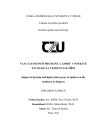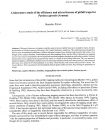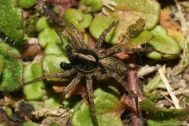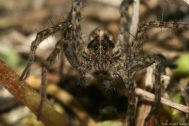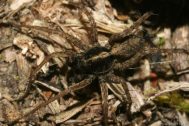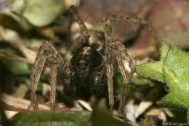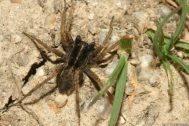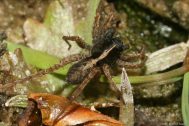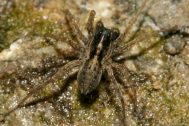| Nálezy podle období | |||||
|---|---|---|---|---|---|
| Lycosidae | 0-1900 | 1901-1950 | 1951-2000 | 2001+ | ∑ |
| Pardosa agrestis (Westring, 1861) Není ohrožený | 1× | 8× | 159× | 302× | 470× |
Pardosa agrestis (Westring, 1861)
| České jméno | slíďák rolní |
|---|---|
| Stupeň ohrožení | Není ohrožený |
| Nálezy | 470 nálezů, 133 kvadrátů |
| První nález |
1894, A. Nosek, Nosek 1895 |
| Poslední nález | 2025 , Aleš Prágr |
| Areál rozšíření | Palaearctic - E-A, eM |
| Fytogeografická oblast |
|
| Původnost stanovišť |
|
| Vlhkost stanovišť |
|
| Stratum |
|
| Osvětlení stanovišť |
|
| Hojnost výskytu |
|
| Nadm. výška | 150-1000 |
Literatura
Intense game grazing shapes epigeic spider communities of pedunculate oak Quercus robur plantations in anthropogenic environments
Game browsing affects nature conservation because the interests of hunters and gamekeepers often lead to high game stocking rates. However, the compositional effects of game browsing on invertebrates are insufficiently understood. We addressed the dynamics of epigeic spider communities in oak stands planted in newly formed anthropogenic environments under the facultative pressure of browsing game. The study site consisted of an open-cast lignite mine and an overburden deposit in NW Czechia. Using pitfall traps, we examined five habitat types (four transects per habitat type): Quercus robur stands ≥ 25 years of age, 12–24 years of age, and 0–2 years of age; Q. robur stands 12–24 years of age that were heavily damaged by game browsing; and sites subject to spontaneous succession for 12–22 years. We captured 9459 individuals from 134 spider species distributed unevenly across the examined habitat types. The young stands were dominated by Pardosa agrestis, Pardosa monticola, and Oedothorax apicatus, whereas Pardosa prativaga, Pardosa lugubris, Pisaura mirabilis, and Alopecosa cuneata dominated the old stands. The stands damaged by browsing had the highest species richness and were dominated by Alopecosa pulverulenta, Xerolycosa miniata, Alopecosa cuneata, and Trochosa ruricola. All the oak stands were rich in threatened species, with most (26) found in habitats damaged by browsing, whereas the youngest stands hosted the lowest number of threatened species (11). The species dominating old stands still included species that prefer greater canopy openness, such as Pardosa lugubris, whereas numerous species of central European climax oak forests were lacking. In conclusion, we identified oak stands heavily damaged by game browsing as a unique environment that shapes the community of epigeic spiders and that differs from epigeic spider communities of oak stands of various ages and those colonizing areas that are allowed to undergo spontaneous succession.
Food provisioning to Pardosa spiders decreases the levels of tissue-resident endosymbiotic bacteria
The diversity, host specificity, and physiological effects of endosymbiotic bacteria in spiders (Araneae) are poorly characterized. We used 16S rDNA sequencing to evaluate endosymbionts in the cephalothorax and legs of a wolf spider Pardosa agrestis. We tested the effects of feeding once or twice daily with fruit flies, aphids, or starved and compared them to those of syntopically occurring Pardosa palustris. The feeding increased traveled distance up to five times in some of the groups provisioned with food relative to the starved control. The Shannon diversity t-test revealed significant differences between these component communities of the two spider species. The increased frequency of feeding with fruit flies, but not aphids, increased the dominance and decreased the alpha diversity of OTUs. The obligate or facultative endosymbionts were present in all analyzed spider individuals and were represented mostly by Rickettsiella, Rhabdochlamydia, Spiroplasma, and the facultative intracellular parasite Legionella. Vertically transmitted endosymbionts were less common, represented by Wolbachia pipientis and Rickettsia sp. H820. The relative abundance of Mycoplasma spp. was negatively correlated with provisioned or killed aphids. In conclusion, the tissues of Pardosa spiders host tremendously diverse assemblages of bacteria, including obligate or facultative endosymbionts, with yet unknown phenotypic effects.
Vliv zastoupení proteinů a lipidů v potravě pavouků na tendenci se šířit.
Disperzní chování pavouků je mezi jiným ovlivňováno různými aspekty, například environmentálními podmínkami či fyziologickým stavem organismu. V navrhovaném experimentu bylo testováno, zda mohla u pavouka druhu Pardosa agrestis mít na toto chování vliv předchozí potravní zkušenost (lipid, protein, základ – s vyváženým poměrem makroživin) nebo potravní deprivace.
Čtyři skupiny pavouků vybraného druhu slíďáka byly v laboratorních podmínkách krmeni octomilkami obecnými Drosophila melanogaster, první skupina bohatými na proteiny, druhá bohatými na lipidy, třetí s vyrovnaným poměrem těchto makroživin a poslední skupina pavouků byla skupinou hladovějící. Poté za vhodných klimatických podmínek, simulovaných v laboratoři, byla sledována tendence testovaných pavouků šířit se pomocí větru.
Cílem bylo zjistit, zda předchozí potravní zkušenost nebo potravní deprivace ovlivňují disperzní chování pavouků. Byl zjištěn rozdíl mezi skupinami ve schopnosti produkce vlečného vlákna, kdy u hladovějících pavouků byla narušena jejich schopnost vlákno produkovat. Dodatečně byl testován vliv orientace vůči světlu a větru mezi jednotlivými úrovněmi diety. Zde bylo zřejmé, že většina pavouků preferovala šířit se po větru směrem ke světlu, z důvodu hledání co možná nepřijatelnějších podmínek pro započetí dostatečně dlouhého vzletu. Taková místa se vyznačují plným osvětlením, a proto k tomuto účelu byla vyhledávána co možná nejosvětlenější místa.
Effects of glufosinate-ammonium herbicide and pod sealant on spider Pardosa agrestis
Herbicides based upon glufosinate‐ammonium (GLA) are among the world’s most widely used. They also are applied on the most prominent oil crops as desiccants in combination with pod sealants to prevent pod shatter and seed loss close to harvest. Even though these crops occupy a significant part of the world’s agroecosystems, the effects of GLA herbicides on non‐target arthropods, and in particular natural enemies of pests, have been studied very rarely, and such effects of pod sealants have never been studied. We studied in our laboratory mortality as well as prey capture efficiency of the common GLA herbicide and desiccant Basta 15 ® , pod sealant Arrest ® , and a mixture of both on the wolf spider Pardosa agrestis. We found that Basta 15 ® and the mixture had lethal effect on spiders. We also found significant, short‐term effect on predatory activity of spiders after all treatments. Basta 15 ® significantly influenced the amount of captured prey also in the long term. This is the first study showing lethal effect on spiders of the herbicide and herbicide plus pod sealant mixture. This is also the first study examining the effects of pod sealant on the mortality and predatory activity of a pest antagonist. More studies regarding the effects of agricultural chemical mixes are needed to uncover their effects on beneficial organisms existing within agroecosystems.Synergistic effects of glyphosate formulation herbicide and tank-mixing adjuvants on Pardosa spiders.
Glyphosate-based herbicides are the world’s most consumed agrochemicals, and they are commonly used in various agroecosystems, including forests, as well as in urban zones and gardens. These herbicides are sold as formulations containing adjuvants. Other tank-mixing adjuvants (most often surfactants) are commonly added to these formulations prior to application. According to the manufacturers of agrochemicals, such tank mixes (as these are known in agronomic and horticultural practice) have modified properties and perform better than do the herbicides as used alone. The effects of these tank mixes on the environment and on beneficial arthropods are almost unknown. Therefore, we studied whether a herbicide formulation mixed with adjuvant has modified effects on one of the most common genera of ground-dwelling wolf spiders vis- a-vis the herbicide formulation and adjuvants themselves. Specifically, we studied the synergistic effect in the laboratory on the predatory activity (represented by the number of killed flies) of wolf spiders in the genus Pardosa after direct treatment using the glyphosate-based herbicide formulation Roundup klasik Pro ® , Roundup klasik Pro ® in a mixture with the surfactant Wetcit ® , Roundup klasik Pro ® in a mixture with the surfactant Agrovital ® , and the surfactants alone. We found that pure surfactants as well as herbicide-and-surfactants tank mixes significantly decrease the predatory activity of Pardosa spiders in the short term even as Roundup klasik Pro ® did not itself have any such effect. Our results support the hypothesis that plant protection tank mixes may have modified effect on beneficial arthropods as compared to herbicide formulations alone. Therefore, testing of pesticide tank mixes is highly important, because it is these tank mixes that are actually applied to the environment.Fotografie
Statistiky
Dle měsíce v roce
Dle nadmořské výšky
Dle metody sběru (470 použitých nálezů)
| Pardosa agrestis (Westring, 1861) ES | Samci | Samice | Mláďata | Nálezy |
|---|---|---|---|---|
| Zemní past | 2859 | 1045 | 86 | 300 |
| Individuální sběr | 61 | 48 | 0 | 50 |
| Smyk | 21 | 13 | 0 | 6 |
| Pozorování | 1 | 0 | 0 | 1 |
| Neurčeno | 36 | 8 | 0 | 61 |
| Žlutá miska | 118 | 32 | 0 | 48 |
| Sklepávání | 1 | 0 | 0 | 1 |
| Prosev | 40 | 7 | 0 | 3 |
| Samci | Samice | Mláďata | Nálezy |
Dle biotopu (470 použitých nálezů)
| Pardosa agrestis (Westring, 1861) ES | Samci | Samice | Mláďata | Nálezy |
|---|---|---|---|---|
| Rákosiny a orobincové porosty stojatých vod | 2 | 5 | 0 | 3 |
| Ostatní pole | 665 | 211 | 59 | 34 |
| Stepi, vřesoviště, písčiny | 11 | 10 | 0 | 1 |
| Suché křoviny | 11 | 9 | 0 | 2 |
| Louky | 4 | 4 | 0 | 7 |
| Suché lesní lemy | 1 | 0 | 0 | 1 |
| Bylinné porosty břehů | 3 | 1 | 0 | 1 |
| Mezofilní louky | 3 | 5 | 0 | 4 |
| Ruderály | 41 | 16 | 0 | 10 |
| Písčiny | 4 | 0 | 0 | 2 |
| Okraje silnic | 8 | 3 | 0 | 4 |
| Bahnité břehy | 1 | 0 | 0 | 1 |
| Travnaté stepi | 1 | 1 | 0 | 2 |
| Neurčeno | 1351 | 546 | 0 | 282 |
| Těžebny písku a jiných nezpevněných hornin | 2 | 9 | 0 | 4 |
| Lesy | 0 | 0 | 0 | 1 |
| Úhory | 3 | 3 | 0 | 3 |
| Paseky | 1 | 1 | 0 | 2 |
| Vřesoviště nižších poloh | 1 | 7 | 0 | 1 |
| Výsadby listnáčů | 0 | 0 | 0 | 1 |
| Slaniska | 2 | 3 | 0 | 2 |
| Obilná pole | 0 | 1 | 0 | 2 |
| Polní biotopy | 32 | 6 | 0 | 4 |
| Suché doubravy | 15 | 12 | 0 | 2 |
| Suché louky | 45 | 20 | 0 | 13 |
| Mokré louky | 56 | 12 | 0 | 10 |
| Vlhké lesní lemy | 2 | 0 | 0 | 1 |
| Haldy a výsypky | 3 | 3 | 14 | 10 |
| Lužní lesy nížin | 206 | 60 | 13 | 13 |
| Kamenolomy | 3 | 1 | 0 | 4 |
| Xerotermní travinobylinná společenstva | 384 | 54 | 0 | 8 |
| Břehy tekoucích vod | 5 | 3 | 0 | 4 |
| Ovocné sady s luční vegetací | 260 | 121 | 0 | 12 |
| Kamenité suti nižších poloh | 1 | 0 | 0 | 1 |
| Skalní stepi na vápenci | 1 | 1 | 0 | 1 |
| Louky | 0 | 6 | 0 | 4 |
| Lesní okraje | 1 | 2 | 0 | 4 |
| Pastviny | 4 | 0 | 0 | 3 |
| Těžební jámy | 0 | 1 | 0 | 1 |
| Dubohabřiny | 1 | 0 | 0 | 1 |
| Obhospodařované pozemky | 1 | 0 | 0 | 1 |
| Stojaté a pomalu tekoucí vody | 2 | 16 | 0 | 3 |
| Samci | Samice | Mláďata | Nálezy |


